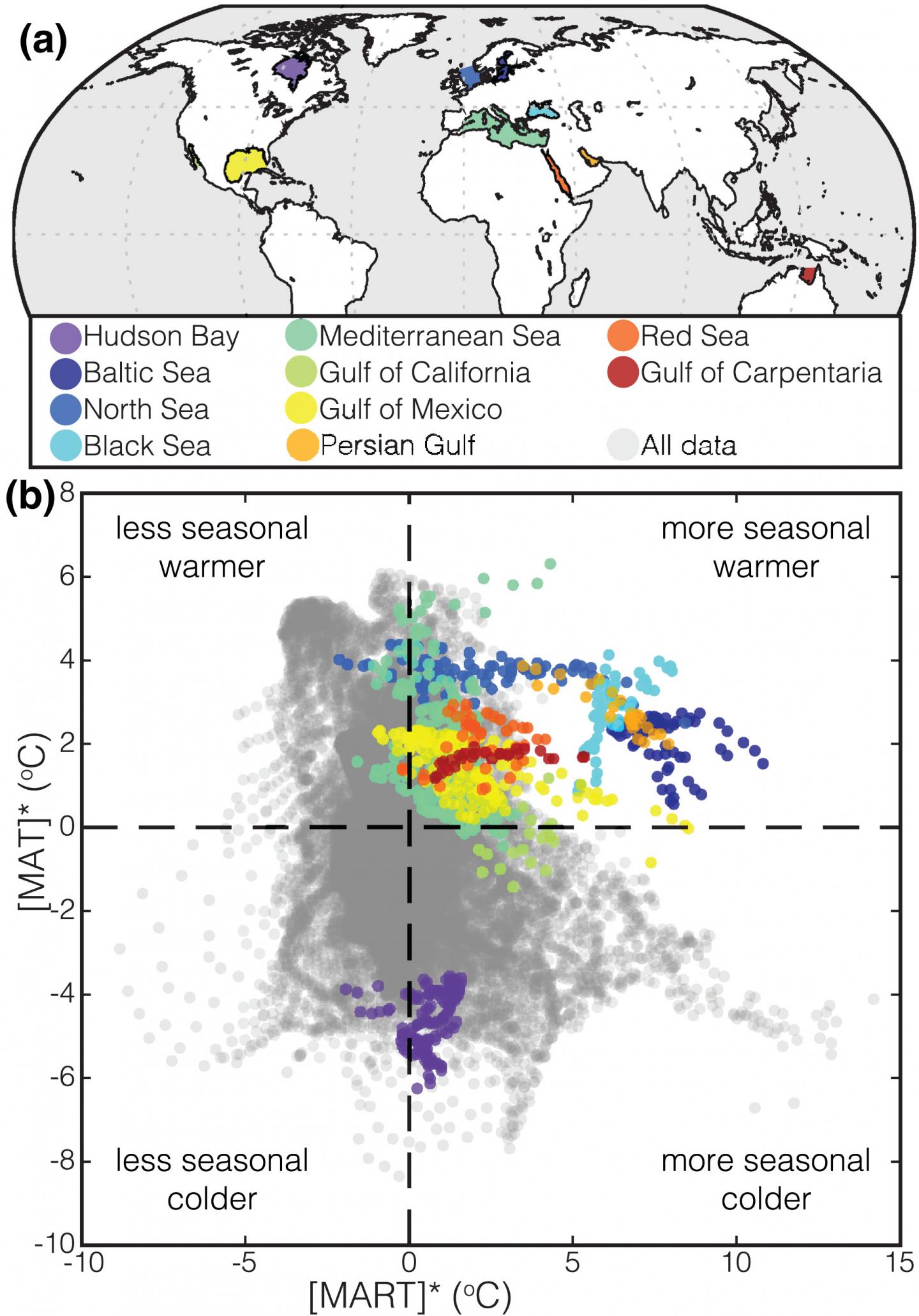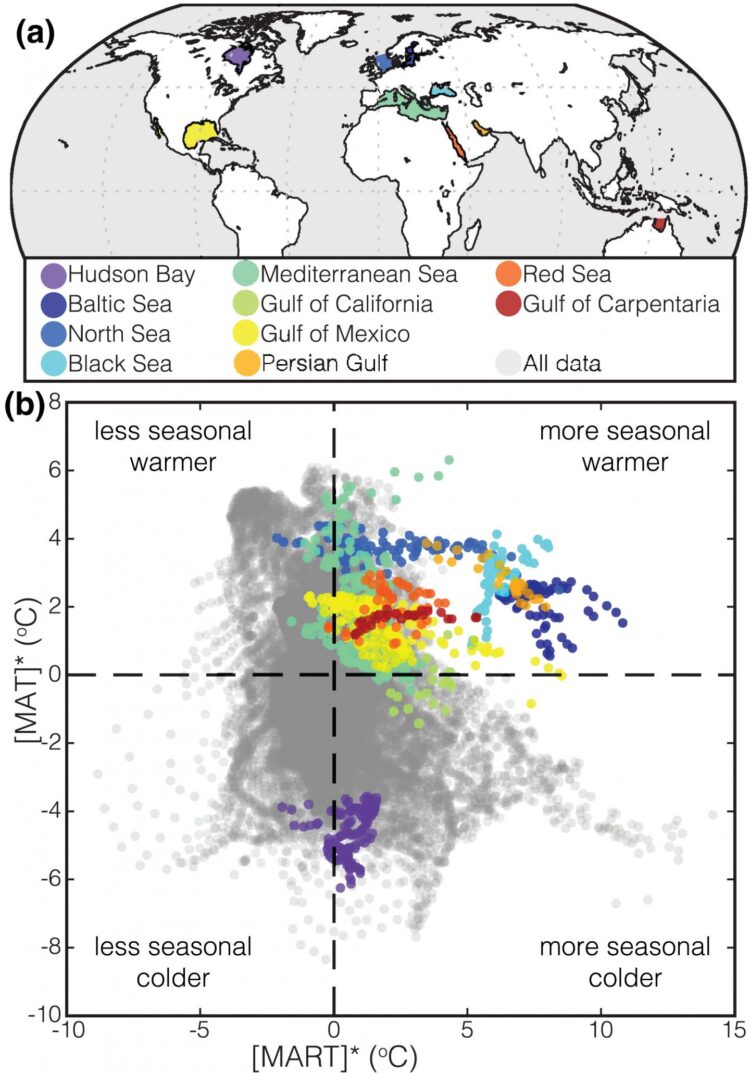
Credit: Syracuse University
A key component when forecasting what the Earth’s climate might look like in the future is the ability to draw on accurate temperature records of the past. By reconstructing past latitudinal temperature gradients (the difference in average temperature between the equator and the poles) researchers can predict where, for example, the jet stream, which controls storms and temperatures in the mid-latitudes (temperate zones between the tropics and the polar circles), will be positioned. The trouble is, many of the existing data are biased toward particular regions or types of environments, not painting a full picture of Earth’s ancient temperatures.
Researchers from the Department of Earth and Environmental Sciences, including Emily Judd ’20 Ph.D., Thonis Family Assistant Professor Tripti Bhattacharya and Professor Linda Ivany, have published a study titled, “A dynamical framework for interpreting ancient sea surface temperatures,” in the journal “Geophysical Research Letters,” to help account for the offset between location-biased paleoclimate data and the ‘true’ average temperature at a given latitude through Earth’s history. Their work was funded by the National Science Foundation.
According to Judd, accurate temperature estimates of ancient oceans are vital because they are the best tool for reconstructing global climate conditions in the past, including metrics like mean global temperature and the latitudinal temperature gradient. While climate models provide scenarios of what the world could look like in the future, paleoclimate studies (study of past climates) provide insight into what the world did look like in the past. Seeing how well the models we use to predict the future can simulate the past tells us how confident we can be in their results. It is therefore of utmost importance to have thorough, well-sampled data from the ancient past.
“By understanding how latitudinal temperature gradients have changed over the course of Earth’s history and under a variety of different climate regimes, we can start to better anticipate what will happen in the future,” says Judd.
To determine ancient temperatures, geologists study proxies, which are chemical or biological traces that record temperatures from sedimentary deposits preserved on the sea floor or continents. Due to the recycling of ancient seafloor into the Earth’s mantle, there is an ‘expiration date’ on the availability of seafloor data. Most ancient temperature proxies therefore come from sediments that accumulated on continental margins or in shallow inland seas where records can persist for much longer.
Judd, Bhattacharya and Ivany use temperature data from modern oceans to reveal consistent, predictable patterns where the ocean surface is warmer or cooler, or more or less seasonal, than otherwise expected at that latitude.
“The biggest offsets happen to be in the two settings that are most represented in the geologic past,” says Ivany. “Knowing how those regions are biased in comparison to the global mean allows researchers to better interpret the proxy data coming from the ancient Earth.”
Data from shallow, semi-restricted seas (e.g., the Mediterranean and Baltic Seas) show that sea surface temperatures are warmer than in the open ocean. As a result, a key finding of their paper theorizes that estimates of global mean temperature from the Paleozoic Era (~540-250 million years ago), a time when the majority of data come from shallow seas, are unrealistically hot.
Even in the more recent geologic past, the overwhelming majority of sea surface temperature estimates come from coastal settings, which they demonstrate are also systematically biased in comparison to open ocean temperatures.
In order to have a more accurate record of average ocean temperature at a given latitude, Bhattacharya says researchers must account for the incomplete nature of paleotemperature data. “Our work highlights the need for the scientific community to focus sampling efforts on under-sampled environments,” says Bhattacharya. “New sampling efforts are essential to make sure we are equally sampling unique environmental settings for different intervals of Earth’s history.”
According to Judd, the paleoclimate community has made major advances toward understanding ancient climates in the past few decades. New, faster, and cheaper analytical techniques, as well as a surge in expeditions that recover ocean sediment cores, have led to massive compilations of ancient sea surface temperature estimates. Despite these advancements, there are still significant disagreements between temperature estimates from different locations within the same time interval and/or between temperature estimates and climate model results.
“Our study provides a framework within which to reconcile these discrepancies,” says Judd. “We highlight where, when and why temperature estimates from the same latitudes may differ from one another and compare different climate models’ abilities to reconstruct these patterns. Our work therefore lays the groundwork to more holistically and robustly reconstruct global climate through Earth’s history.”
###
Media Contact
Daryl Lovell
[email protected]
Original Source
https:/
Related Journal Article
http://dx.





